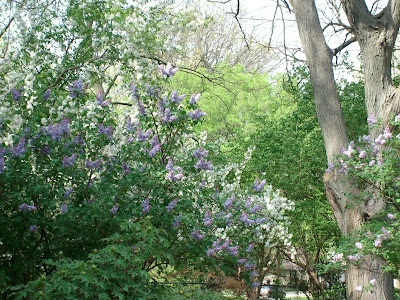Warm days have finished up the early bulbs and flowering trees and shrubs. Forsythia, star and saucer magnolia, quince, weeping cherry, pear ... are leafing out and their flowers are finished. But the next wave of blooms has begun: crapapple trees in white, pink, and deep rose are in bloom all over town, along with red bud, fragrant viburnum bushes, and ... LILACS!
Ever since I was a little girl, I have loved lilacs of all kinds. The fragrance is wonderful (BTW, I adore French Lilac all-vegan natural fragrance and body butter by Pacifica) and the flowers themselves are so delightful. I love the way the cone-shaped panicles open toward the end, so that the tips have the darker color of the unopened buds.
Lilacs take patience. Unless you get an unusually large plant to start with, you often wait three years for the first blooms. I'm not sure how long ago I planted the shrubs pictured here, on both sides of the two-seater glider in my north yard, but it was at least ten years, I think. This year, they are blooming beautifully.
On the north fence, I have a considerably younger lilac with just a few blooms. But it is fascinating because of the two-tone coloring. This variety is called "Sensation." It is also sweetly fragrant.
In addition to lilacs (Syringa vulgaris), the white crabapple (Malus hybrid) in my yard is blooming nicely this year. When we first moved in, it didn't bloom for several years and we pruned it hard. It must have "scared" it into action because it has bloomed every spring since then!
The apple blossoms have a sweet smell, and, when they finish up it looks like snow on the ground beneath. I never have seem little crabapples on this tree, however, so I assume it's a sterile variety, bred so that all the energy goes into producing flowers.
It doesn't show in this photo, but there are "fragrant rose" daffodils (white with pink trumpets and late-blooming) planted in a circle underneath the crapapple.
I find that the combination of the lilacs and the crabapple is a delight. The crabapple is actually a little behind and between the two lilac bushes.
Another beautiful shrub in bloom in my yard now is the Dwarf Double Almond (Prunus glandulosa). It isn't really scented, but the light pink and the delicate but fully double flowers are a treasure!
I also enjoy viburnums of many varieties. Some have early spring flowers that are very fragrant; others are loved for their bright red or bright blue berries for the birds. Here's Viburnum juddii, an early and sweet-smelling type.
Some shrubs and small trees are beautiful in the spring because of the color and shape of their first leaves rather than flowers per se. This very dissect (delicately cut leaves) Japanese maple is a good example.
The fothergillia (Fothergillia gardenii) isn't very common here, but it is very easy to grow and undemanding. The flowers, which look a bit like little ivory bottle brushes, smell like honey!
Besides the shrubs and trees, perennials and woodland flowers are starting to bloom as well. I love the flowing shape of the bleeding heart (Dicentra spectabilis).
The woodland delphinium (Delphinium tricorne), also called the dwarf larkspur, is such a wonderful purple color.
In the shade, the modest pulmonaria (Pulmonaria saccharata), also called lungwort, shows off its spotted foliage and small blue and pink flowers.
I know I said that the bulbs were finished, and most of them are, but I found a few later-blooming species tulips here and there in my scree beds.

I hope you liked these flower pics. I do plan to include blog posts about topics other than spring blooms, but bear with me for a while yet. Next post will be about blooms in the garden of my friend Eleanore.


















Lovely, lovely photos! I also love to take photos of flowers, and it is so exciting after a long winter to see them again.
ReplyDeleteThanks for sharing!